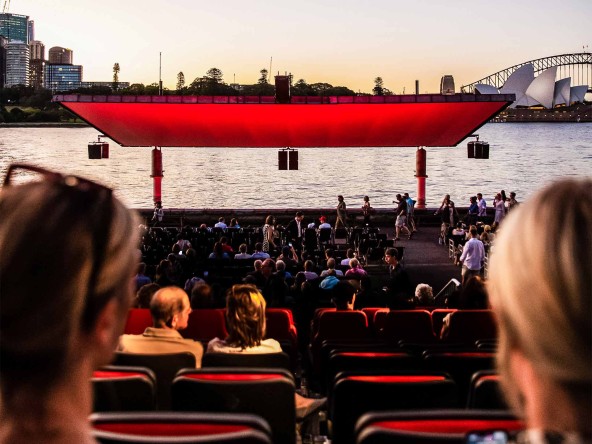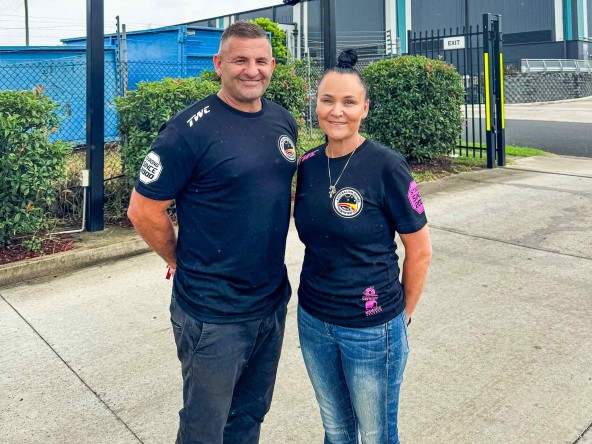
5 minutes - magazine 02 | 2024
A great show
In Sydney Harbour, opposite the world-famous Opera House, the city skyline and the Harbour Bridge, an enormous screen has been regularly hoisted into the air for 27 years.
Playtime in Sydney – a screen goes around the world
From January to February, when it is summer in Australia, an open-air cinema is set up in the botanical garden – at a location that a French fashion magazine once named the “most beautiful cinema in the world”.

Equipped with a 40-tonne counterweight, the LTM 1350-6.1 is extremely stable.
The screen resembles a sail and measures 25 by 13 metres. Mounted on a scaffold, it is erected every year 25 metres from the shore in Sydney Harbour. To assemble the screen, a crane is needed on land and divers are needed underwater to put all the steel components in the right place. Precision and an adept technical approach to the construction work are essential attributes for everyone involved.
This spring, local crane service provider Two Way Cranes was responsible for the lift and used an LTM 1350-6.1 – the exact same crane that did the same job for Gillespie Cranes in 2015. Coincidence? No. “When we took over Gillespie Cranes five years ago, we added ten of their machines to our fleet,” explains Frank Zammit, Managing Director of Two Way Cranes. For years, the organiser Westpac and screen rental company Cinerent have been able to rely on tried-and-tested machines and a well-coordinated team.

The divers and crane drivers are a well-rehearsed team.
Light work
Equipped with a 40-tonne counterweight, the lift was easy for the 350-tonne crane. “The garden area where the crane erected the screen offers good access and sufficient open space. The heaviest parts weighed nine tonnes and had to be installed at a radius of 31 metres,” explains Dave Gillespie, the project manager responsible for this assignment in the botanical garden.
There is a solid foundation at the bottom of the harbour to which the pylons are attached. “These are removed every time the canvas is dismantled so as not to interfere with shipping traffic,” explains Two Way Cranes operator Adam Morris, who carried out the lift together with advanced rigger and fellow operator, Craig Ainsworth. Both men became familiar with Liebherr at a very young age. Even their fathers worked with cranes from Ehingen back in the day.
During the two-day job, Morris and Ainsworth performed around 100 lifts. One of the special aspects of this job is that the crane driver communicates with the divers via a supervisor in order to anchor the piers underwater in the foundations.

When the screen rises in Sidney Harbour, the audience falls silent.
In demand internationally for over 20 years
A special feature of the cinema screen, which is used worldwide, is its folding function. “Its enormous size of 350 m² offers a correspondingly large area exposed to the wind. To ensure safety, the screen is hydraulically foldable,” says Rob Bryant, Managing Director of screen hire company Cinerent in Australia. “Whatʼs more, the cinema events – no matter where in the world – take place in beautiful locations. Therefore, whenever the screen isnʼt being used, it is folded down to keep the view clear.”

Frank and Nichole Zammit outside the company headquarters in Sydneyʼs Western suburbs.
Bryant has been involved as a creative mind for almost as long as the event itself has existed. “There have been some emotional and amusing moments,” he recalls, recounting how 1,700 people sang along to Youʼve Lost That Loving Feeling at a screening of Top Gun or how a streaker ran in front of the screen during a surf film – to thunderous applause from the audience. At such an event, it is only natural that international film stars should present their latest works. Sylvester Stallone, Nicole Kidman and director Danny Boyle have all appeared in front of the screen at Sydneyʼs open-air cinema.
- In 1993, the Swiss company Cinerent began developing mobile open-air cinema screens.
- At 350 m², the Cinerent screen is one of the largest in the world and is in demand internationally from Europe to Australia.
- Continuously upgraded over the years, it can withstand wind speeds of up to 55 km/h.
- Four freight containers are needed to ship the screen together with the sound equipment and projection booth.
This article was published in the UpLoad magazine 02 | 2024.



